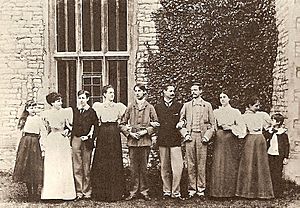Oliver Strachey facts for kids
Oliver Strachey (born November 3, 1874 – died May 14, 1960) was a clever British codebreaker. He worked for the government in the Foreign Office. Oliver helped break secret codes during both World War I and World War II.
Contents
Early Life and Education
Oliver Strachey was born into a large and interesting family. His father, Sir Richard Strachey, worked for the government in India. His mother, Jane Maria Strachey, was a writer and fought for women's right to vote.
Oliver had many siblings, including the famous writer Lytton Strachey. He went to a well-known school called Eton College. Later, he briefly studied at Balliol College, Oxford University.
Oliver's parents sent him on a trip around the world. He also studied piano in Vienna, Austria. He was good at playing, but not good enough to be a concert pianist. So, he returned to England and joined the Foreign Office.
Family Life and Early Career
Oliver Strachey was married twice. His first marriage was in 1900 to Ruby Julia Mayer. They had one daughter named Julia Strachey.
In 1911, he married Ray Costelloe. They had two children together. Their daughter, Barbara Strachey, became a writer. Their son, Christopher Strachey, grew up to be a very important person in the early days of computers. He helped create computer languages.
While working in the Foreign Office, Oliver also did historical research. He wrote a book with his wife Ray. It was about a historical event in India called Keigwin's Rebellion. The book was published in 1916.
Becoming a Codebreaker
Oliver Strachey became a key figure in British codebreaking.
World War I Codebreaking
During World War I, Oliver worked in British Military Intelligence. This was a special group called MI1. They were responsible for gathering and understanding secret information.
Between the Wars: Government Code and Cypher School
After World War I, Oliver continued his work with codes. He joined the Government Code and Cypher School (GC&CS). This was Britain's main codebreaking center.
In 1934, Oliver Strachey and another codebreaker, Hugh Foss, achieved a big success. They managed to break a complex Japanese naval code. This was a very important breakthrough for British intelligence.
World War II: Bletchley Park and ISOS
When World War II began, Oliver Strachey worked at Bletchley Park. This was the top-secret center for British codebreaking. He led a special section there called ISOS.
The ISOS section was responsible for decoding messages from German agents. These agents were secretly working for the British (part of the Double Cross system). The first decoded message from this system was sent out in April 1940. The code name for these messages was "Pear," but they later became known as ISOS. This stood for "Illicit Services (Oliver Strachey)."
In early 1942, another person named Denys Page took over as the head of the ISOS section.
Work in Canada
In December 1941, Oliver Strachey traveled to Ottawa, Canada. He became the chief codebreaker at the Examination Unit. This was Canada's own secret codebreaking department, similar to Bletchley Park.
Before Oliver arrived, a man named Herbert Osborne Yardley had been working there. Yardley had written a book that revealed many secrets about codebreaking. Because of this, the American government did not want him to continue. Oliver Strachey refused to go to Ottawa until Yardley had left the city.
Oliver brought important code keys with him from England. These keys helped break high-level French and Japanese diplomatic codes. This led to closer teamwork between codebreakers in Washington, London, and Ottawa. Even though Oliver did not speak or read Japanese, he helped break their very complex codes. He returned to Bletchley Park in September 1942.
Later Life and Recognition
Oliver Strachey enjoyed music and reading in his free time. For his important work, he was honored in 1943. He was made a Commander of the Order of the British Empire (CBE).


